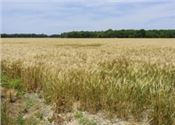|
Fewer Acres, But Wheat Harvest Finishes Strong

Mississippi wheat growers averaged 62 bushels per acre as they harvested significantly fewer acres for the second consecutive year – about 50,000 total acres. Until recent years, growers averaged 200,000 acres of wheat in the state.
Photo by MSU Extension Service/Kevin Hudson
STONEVILLE, MISS.
Mississippi’s wheat yields were the silver lining in an otherwise depressing season with reduced acreage and a weak market.
Until recent years, growers averaged 200,000 acres of wheat in the state. This year, growers planted about 50,000 acres, and estimated yields have averaged 62 bushels per acre, a 4-bushel increase from last year.
Larry Falconer, agricultural economist with the Mississippi State University Extension Service, said prices are up about 6 cents per bushel compared to this same point last year.
“For the last week in June, the price of soft red winter wheat at Greenville averaged $4.80 per bushel compared to $4.74 per bushel the same week a year ago,” he said. “Large world supplies of wheat relative to usage are hampering the ability of wheat prices to move higher.”
Falconer said that over the past 30 years, average world supplies of wheat on hand at the end of a marketing year would have been sufficient to cover 108 days of use.
“The expected number of days of use on hand at the end of the 2018-2019 crop year is 129 days -- historically, a very high number for the world supplies,” he said. “The increase in supply is primarily due to increases in production over the last several years in the former Soviet Union and India.”
The ag economist said U.S. wheat prices are expected to be slightly higher than last year, as U.S. carryout stocks are expected to decline slightly based on a 1.83-billion-bushel crop and total use of 2.1 billion bushels.
“Prices are expected to average about 25 cents per bushel higher than last year,” Falconer said. “Still, wheat acreage in Mississippi this fall probably won’t exceed 65,000 acres, based on the current price outlook.”
MSU Extension grain crop specialist Erick Larson said most wheat farmers are “pretty happy” with the past growing season, which had minimal disease pressure.
“Mississippi was relatively wet in April, but dry conditions in May helped improve wheat yields in most areas,” he said. “Still, there were other areas that may have been hurt by the hot conditions.”
Larson said growers suffered through the second consecutive drought during the fall planting season, causing late plantings and reduced acreage.
“We had a couple of frosts during April, which can be among the most damaging events that could happen,” he said. “Freezes usually occur near wheat heading time, and that’s a vulnerable stage. That was not the case this past spring, as most of our wheat was not as far along because of some cool spring temperatures.”
Spring conditions also prevented the crop from maturing faster.
“Some growers in northeast Mississippi were still harvesting the last days of June, which is exceptionally late,” Larson said. ∆
|
|